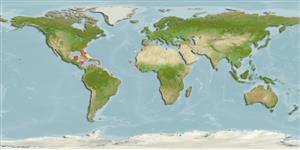>
Anguilliformes (Eels and morays) >
Ophichthidae (Snake eels) > Ophichthinae
Etymology: Callechelys: Greek, kalos, kallos = beautiful + Greek, enchelys, -yos = eel (Ref. 45335).
Environment: milieu / climate zone / depth range / distribution range
বাস্তুসংস্থান
সামুদ্রিক তলদেশ বিহারী; গভীরতার পরিসীমা 4 - 35 m (Ref. 4455). Tropical
Western Atlantic: western and eastern Florida, Puerto Rico, the Bahamas, St. Barthelemy and possibly Venezuela. Lesser Antilles (Ref. 26938). Eastern Atlantic: Senegal and Cape Verde.
আকৃতি / ওজন / Age
Maturity: Lm ? range ? - ? cm
Max length : 108 cm TL পুরুষ/ লিঙ্গ অনিধর্ারিত ; (Ref. 27478)
Burrows in sand or mud on the continental shelf from near shore to 35 m depth (Ref. 4455). Formerly Callechelys perryae. Minimum depth from Ref. 58018.
Life cycle and mating behavior
পরিপক্কতা | প্রজনন | ডিম ছাড়া | ডিমসমূহ | ডিম্বধারন ক্ষমতা | শুককীট
McCosker, J.E., 1998. A revision of the snake-eel genus Callechelys (Anguilliformes: Ophichthidae) with the description of two new Indo-Pacific species and a new Callechelyin genus. Proc. Calif. Acad. Sci. 50(7):185-215. (Ref. 27478)
IUCN Red List Status (Ref. 130435)
Threat to humans
Harmless
Human uses
আরো তথ্য
প্রচলিত নাম সমূহপ্রতিনাম সমূহবিপাকশিকারী প্রাণী সমূহপরিবেশ বিষাক্ততাবিদ্যাপ্রজনন পরিপক্কতা ডিম ছাড়া ডিমের সংগ্রহ ডিম্বধারন ক্ষমতা ডিমসমূহEgg development
Age/Size
বৃদ্ধি
Length-weight
Length-length
Length-frequencies
মরফোমেট্রিক্স
বহিঃ অঙ্গ সংস্থান
শুককীট
শুককীটের সত্রিুয়তা
নির্বাচন
প্রাচুর্য
BRUVS
সূত্র সংখ্যা এ্যাকুয়াকালচার (জলজ পালন) এ্যাকুয়াকালচার নকশা বংশ বংশানুগতিবিদ্যাElectrophoresesউতরাধিকার সুত্রে পাওয়া যোগ্যতারোগ প্রক্রিয়াজাতকরণ NutrientsMass conversion
হাতিয়ার
Special reports
Download XML
ইন্টারনেট সুত্র
Estimates based on models
Preferred temperature (Ref.
123201): 24.2 - 28, mean 26.6 °C (based on 164 cells).
Phylogenetic diversity index (Ref.
82804): PD
50 = 0.5000 [Uniqueness, from 0.5 = low to 2.0 = high].
Bayesian length-weight: a=0.00089 (0.00039 - 0.00204), b=3.00 (2.80 - 3.20), in cm total length, based on LWR estimates for this (Sub)family-body shape (Ref.
93245).
ট্রফিক পর্যায়ে (Ref.
69278): 3.9 ±0.6 se; based on size and trophs of closest relatives
স্থিতিস্থাপক (Ref.
120179): মাধ্যম , সর্বনিম্ন প্রজন দ্বিগুনের সময় ১.৪-৪.৪ বৎসর (Preliminary K or Fecundity.).
Fishing Vulnerability (Ref.
59153): High vulnerability (65 of 100).
